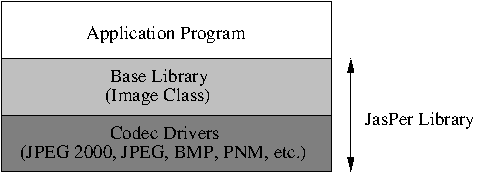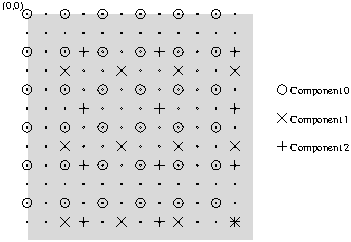The heart of the JasPer software is the JasPer library. In fact, most of the code in JasPer is associated with this library (as opposed to the JasPer sample application programs). The JasPer library provides classes for representing images, color profiles (i.e., color space definitions), and other related entities. Each of these classes has a well-defined interface through which an application may interact with class objects. The library can be used to manipulate images, import/export image data in a variety of formats, and perform basic color management operations.
Conceptually, the JasPer library is structured as shown in Figure fig__swstruct. The library consists of two distinct types of code:
The core code provides the basic framework upon which the library is built, while the codec drivers only provide the means for encoding/decoding image data in various formats. All application interfaces are through the core code. The codec drivers are only ever directly called by the core code, never by an application.
The codec support in the JasPer library is both modular and extensible. A well-defined interface exists between the core code and codec drivers. Moreover, support for a new image format can be easily added without having to modify the library in any way. To do so, a codec driver for the new format simply needs to be provided. Furthermore, an application need only include codec drivers for the image formats that it will use. In this way, an application can avoid the cost of increased memory consumption for codec drivers that are never to be employed.

To avoid name space collisions, all of the identifiers used by the core code are prefixed with either jas_ or JAS_. The core code provides a number of key classes. Some of these classes include the following:
jas_image_t). This class is used to represent an image. Methods are provided for such things as:jas_cmprof_t). This class is used to define a color space. Such a definition is made relative to a reference color space such as CIE XYZ or CIE Lab [icc_fffcp].jas_cmxform_t). This class is used to apply a color space conversion to image data. A color space transform is created from two or more color profiles.jas_stream_t). This class provides I/O streams similar to that of standard C library [iso9899-2011], but with additional functionality required by other code in the JasPer library. This extra functionality includes:jas_tvp_t). This class is used to parse strings containing one or more tag-value pairs. A tag-value pair is a string of the form "tag=value". Tag-value pairs are used by some interfaces within JasPer in order to pass parameters. For example, such pairs are used to pass options to codec drivers for encoding/decoding operations. Methods are provides for such things as:In addition to the above classes, some other functionality is provided, including command line parsing routines (similar in spirit to UNIX getopt).
The core code provides a framework for housing codec drivers. A codec driver provides the means for encoding/decoding of image data in a particular format. Each driver provides three methods:
The encoding method emits the coded version of an image (i.e., a jas_image_t object) to a stream (i.e., a jas_stream_t object). The decoding method creates an image (i.e., a jas_image_t object) from the coded data in a stream. The validation method is used to quickly test if the data in a stream is formatted correctly for the image format in question. This particular method is used for the autodetection of image formats.
The codec drivers provided with the JasPer distribution are written in order to accommodate streamed data. In other words, image data streams are always processed in a single pass. This design philosophy eliminates the need for a stream object to be seekable. As a result, it is possible to write application programs that receive data from, or send data to, pipelines or other entities that do not support random access to data.
The set of applications for which JasPer may be a useful tool is dictated, in part, by the image model that JasPer employs. Therefore, it is prudent to introduce this model here. The image model employed by JasPer is quite general and partially inspired by the one used in the JPEG-2000 standard.
An image is comprised of one or more components. In turn, each component consists of rectangular array of samples. This structure is depicted in Figures fig__imgmodel_a and fig__imgmodel_b. The sample values for each component are integer valued, and can be signed or unsigned with precision from 1 to (nominally) 16 bits/sample. The maximum allowable precision is platform dependent. Most common platforms, however, should be able to accommodate at least 16 bits/sample. The signedness and precision of the sample data are specified on a per-component basis. All of the components are associated with same spatial extent in an image, but represent different types of information.


There is considerable flexibility in the interpretation of components. A component may represent spectral information (e.g., a color plane) or auxiliary information (e.g., an opacity plane). For example, a RGB image would have three components, where one component is associated with each of the red, green, and blue color planes. A RGBA (i.e., RGB with transparency) image would have four components, one associated with each of the red, green, blue, and alpha planes. The various components need not be sampled at the same resolution. In other words, different components may have different sampling periods. For example, when color images are represented in a luminance-chrominance color space, it is not uncommon for the luminance information to be more finely sampled than the chrominance information.
Since an image can have a number of components, a means must exist for specifying how these components are combined together in order to form a composite image. For this purpose, we employ an integer lattice known as the reference grid. The reference grid provides an anchor point for the various components of an image, and establishes their alignment relative to one another.
Each component is associated with a rectangular sampling grid. Such a grid is uniquely specified by four parameters:
The samples of a component are then mapped onto the points where the sampling grid intersects the reference grid. In this way, sample $(i,j)$ of a component is mapped to the position $(\text{HO} + i \text{HS}, \text{VO} + j \text{VS})$ on the reference grid.
To clarify the above text, we now present an illustrative example. Consider an image with three components. For the $k$th component, let us denote the horizontal grid offset, vertical grid offset, horizontal grid spacing, and vertical grid spacing, as $\text{HO}_k$, $\text{VO}_k$, $\text{HS}_k$, and $\text{VS}_k$, respectively. Suppose, for example, that these parameters have the following values:
| $k$ | $(\text{HO}_k, \text{VO}_k)$ | $(\text{HS}_k, \text{VS}_k)$ |
|---|---|---|
| 0 | (0, 0) | (2, 2) |
| 1 | (2, 3) | (3, 4) |
| 2 | (3, 2) | (4, 3) |
In this scenario, the component samples would be aligned on the reference grid as illustrated in Figure fig__refgridex. Perhaps, it is worth nothing that the above set of parameter values was chosen in order to provide an enlightening example, and is not meant to represent a set of values that is likely to be used with great frequency by applications.

From above, we can see that the image model used by JasPer is quite general. The main constraint imposed by this model is that rectangular sampling must be employed. The vast majority of applications, however, use such sampling. Also, with JasPer, one can easily accommodate grayscale, color, and other multi-band data (with or without opacity information).
Since the image model employed is true color (i.e., not palettized), the codec drivers are responsible for palettization and depalettization in the case of image formats that utilized palettized representations.
In order to use the JasPer library, a C source file normally must include the main JasPer library header file jasper/jasper.h. This can be accomplished with the following preprocessor directive:
#include <jasper/jasper.h>
The main header file includes all of the other library header files. Therefore, in order to insulate application code from possible changes to the names of the other library header files, one should only ever include the main library header directly.
The first usage of the library must always be to initialize it. This is accomplished as described in Configuration, Initialization, and Shutdown. If any functionality of the library is used before initialization is performed, the resulting behavior is undefined.
All memory allocation in the libjasper library is performed via the functions jas_malloc(), jas_realloc(), jas_calloc(), and jas_free(). The underlying memory allocator used by these functions can be controlled by the application. By default, an alloator based on malloc() is used. If one is trying to port the JasPer code to an embedded platform, it might be necessary to use a custom memory allocator instead. More detailed information on memory allocators for JasPer can be found in Memory Allocators and the Allocator Wrapper.
Support for new image formats can be easily added to JasPer. In order to add support for a new image format, one must provide three functions:
The encoding function emits the coded version of an image (i.e., an jas_image_t object) to a stream (i.e., a jas_stream_t object). The decoding function creates an image (i.e., a jas_image_t object) from the coded data in a stream (i.e., a jas_stream_t object). The validation function is used to quickly test if a data stream is formatted correctly for the image format in question. (This functionality is necessary for the autodetection of image formats.)
The precise interface provided by each of the encoding, decoding, and validation functions is as follows:
int (*encode)(jas_image_t *image, jas_stream_t *out, const char *opts);
Encode image data to a stream. The image pointed to by image is encoded in accordance with the options specified in the null-terminated string pointed to by opts and written to the stream out. The options string is a whitespace-delimited sequence of tag-value pairs. If the encoding operation is successful, zero is returned. Otherwise, a nonzero value is returned.
jas_image_t *(*decode)(jas_stream_t *in, const char *opts);
Decode an image from a stream. The image data from the stream in is decoded in accordance with the options specified in the null-terminated string pointed to by opts. The options string is a whitespace-delimited sequence of tag-value pairs. If the decoding operation is successful, a pointer to the decoded image is returned. Otherwise, a null pointer is returned.
int (*validate)(jas_stream_t *in);
Determine if stream data is in a particular format. The first few characters of the stream in are examined in order to determine if the stream is encoded in the format supported by the codec. The characters examined are not removed from the stream. (In other words, the current read/write position in the stream is left unchanged by this function.) If the format is supported by the codec, zero is returned. Otherwise, a nonzero value is returned.
Numerous examples of these types of function can be found by examining the code for the image formats already supported by JasPer (e.g., BMP, JP2, JPC, MIF, PGX, PNM, RAS, and JPEG). Once the above functions have been written, the JasPer library can be made aware of the new image format through a call to jas_image_addfmt(). This call, of course, must be made after the JasPer library has been initialized.